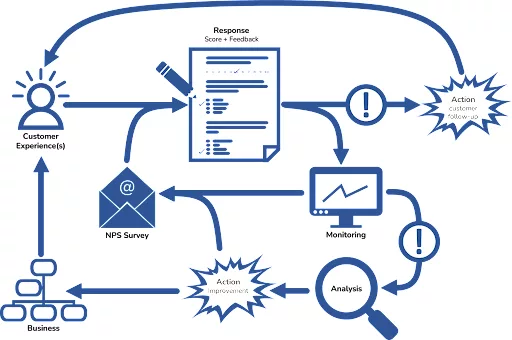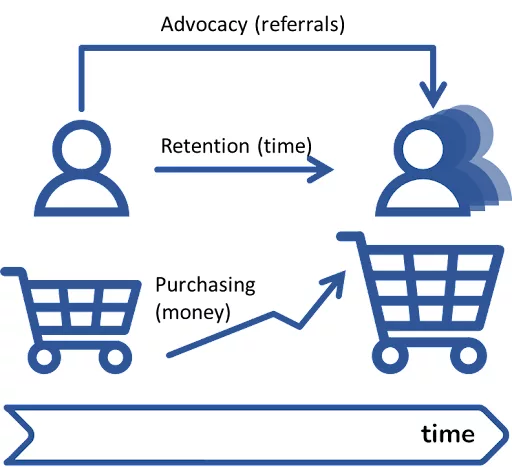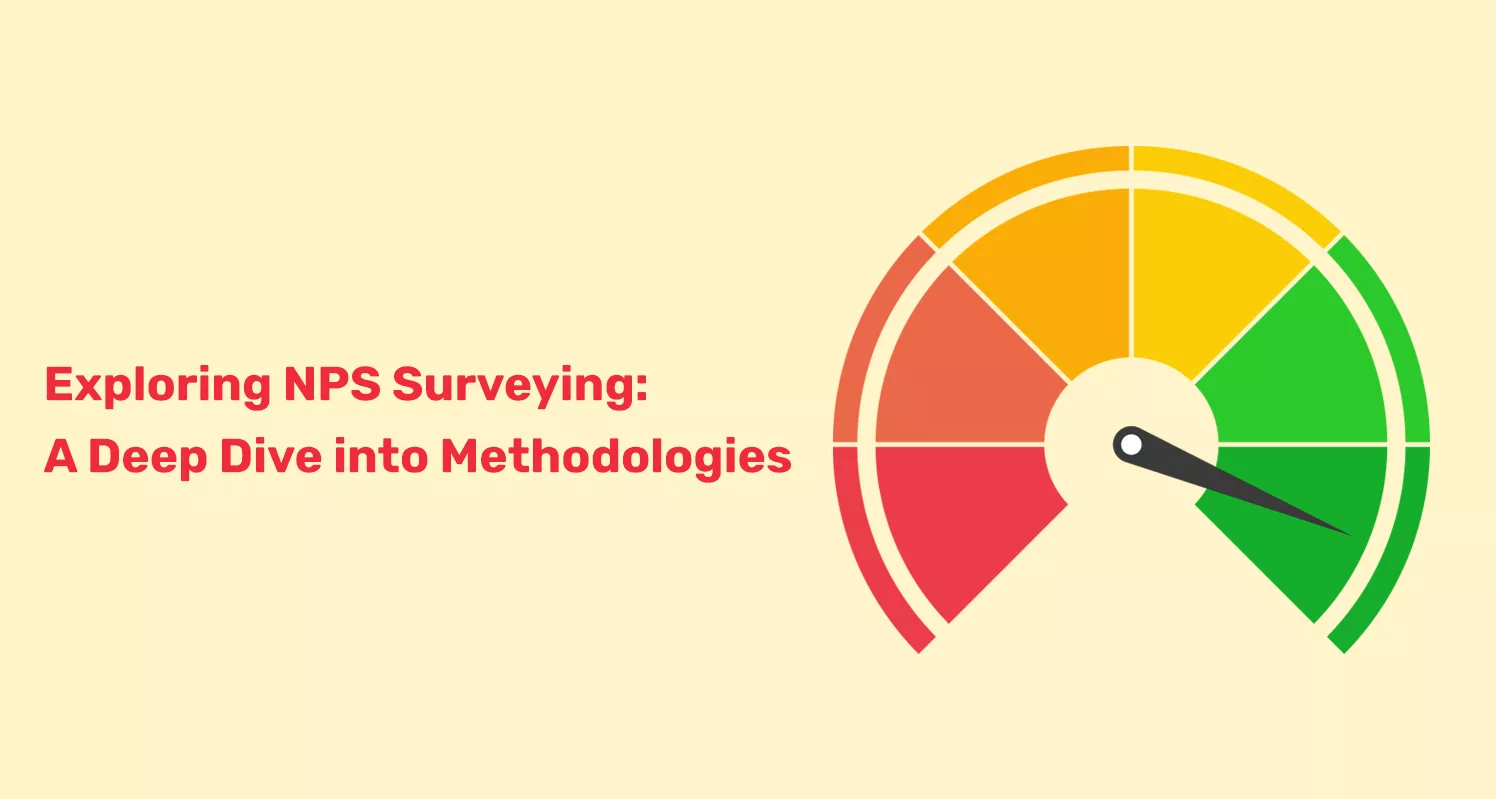
Post-survey actions
Having successfully elicited responses for your NPS surveys from your customers, the next step is to act on these results.
The Net Promoter Score is, as we have seen, a good indicator of customer sentiment and widely used as a predictor of future revenue/profit. For this reason the attained NPS receives a lot of attention as a performance measure and customer feedback that (together with responses to follow-on questions) provides important insight into strength and weaknesses and how your business processes may be improved. This is as it should be. However it is a wasted opportunity (and a mistake of many businesses) not to directly follow-up on the feedback provided by the survey and respond to particular customer experiences. Let’s start by looking at how customer follow-up should be managed.

Customer follow-up
The first actions to be considered are follow-ups to responders. A minimum response is to send out personalized messages to all responders. You should then consider how to tune your response accordance with the customers scoring group.
Detractors, the group with NPS values in the 0 – 6 range, should be of immediate concern. These customers carry a high risk of churn and may cause much more harm to your reputation by spreading negative views than you’re the good messages put out by your Promoters. Therefore you must have a plan in place for immediately attending to Detractors. Here are some pointers of your response to prevent them defecting to your competitors:
- Be prepared. Your business should not respond to Detractors without a plan for handling the situation. The plan should take into account various scenarios and be goal oriented. The goal should be to recover from the situation by preventing defection of the customer.
- Ensure your customer facing representatives have the right communication skills and are training.
- Don’t waste time during which your customer may defect. Reach-out to Detractors at once by telephone or by email and prove your concern to them with the immediacy of your response. Just receiving your attention so quickly, can in many cases positively alter customer perceptions.
- Ensure your customer-facing representatives can and do learn about customers and their customer experiences before they make contact with the customer. Ensure your system can provide customer history including purchases, issues and resolutions, comments and communications, and survey responses to furnish an understanding of how the customer feels about your business and products/services.
- Have that customer-facing representatives’ approach discussing negative experience(s) with Detractors, with empathy and attempting to relate to their position. Ensure they are made aware that your business is concerned with the situation and wants to remedy it, and that their views are valued as important feedback in helping to improve your products/services in the future.
- Make sure that communication is carried in a respectful, measured, calm and objective language. The right tone can have a very positive impact on customer attitudes. Customers should be listened to actively, with the intent to understand. Clarifications and additional information should be sought, demonstrating the value placed on their ideas and that their concerns are being taken aboard.
- If possible have Detractors furnished with evidence of how their problem will be addressed. Ensure the plan to win-over Detractors includes a “compensation”, consummate with the problem and the path that the communication takes. The compensation may be simply an apology or a benefit (such as a discount for future purchases, a refund, or an upgrade) or both.
After communication with the Detractors has been established and their concerns understood, your business must then resolve the problem and fulfill any promises made to them.
To check the success of your actions and close the loop, the Detractors should be contacted again with follow-up telephone calls or emails. Provide update on their issues in the interim. If you have alleviated their issues, responded with a suitable apology and/or benefit to compensate for their frustration, and have demonstrated how you have taken-aboard their concerns to improve your products and services, there is a high probability that you will have turned them into Promoters, a fact that you should monitor vis-à-vis those customers.
The foregoing, is all about Detractors, due to the urgency of retaining them. This does not mean that Promoters and Passives should not be paid attention! Understanding such loyal customers exposes the strengths of your business which you should strive to protect and develop. Get back to Promoters, thank them for their feedback and demonstrate to them their views are valued. Don’t assume that just because they are Promoters that they have no problems with their customer experience. Engage with them to understand and address these issues, and reinforce their loyalty through suitable gifts, and promotions. Ask them if they would be interested in providing testimonials. In this way contribute to building a sense of community around your brand/products.
Similarly, do not let Passives to be forgotten. They are not infrequently the largest of your customer groups. Remember that a small nudge can convert them in to Detractors or Promoters.
Monitoring
Of course the overall NPS value obtained through your surveys is very important to evaluate the direction your business is moving in and to measure the performance of groups within your organization. As NPS surveys are performed your business NPS value will change and you will want to know the reason. Plotting overall NPS values through time is a relatively simple task, but when the value changes you will want to understand the cause of the change. Typically you will want to drill-down to segment level NPS values to determine the contributors in terms of customer segments. In addition you will require to monitor the progress of responses from closed-ended follow-on questions. A dashboard that that facilitates the visualization of these trends and possesses drill-down capabilities is invaluable for timely intervention.
Analysis and organizational follow-up
Changes in overall or segment level NPS (or the lack of expected change) are cues for process change. If the change is positive, you will want to reinforce the organizational innovations that led to it. If the change is in the negative direction, you will want to analyze survey data to understand which segments of the customer population are driving the change, the reasons and remedies. Further segmenting data will provide insight, as well as trends in closed-ended follow-on question responses. Representative customer survey responses and associated customer journeys will provide a more detailed picture of how processes failed to deliver. The open-ended customer responses may provide potentially valuable qualitative data for this analysis.
Of course NPS is not the only performance measure you may have at hand. There are many statistics such as Customer Satisfaction Score, Customer Effort Score (for customer convenience), Customer Retention Rate and Churn Rate are just some examples. Each of these measures have separate merits and measure customer satisfaction from differing perspectives. The can be used together with NPS to produce a fuller picture. In addition NPS results may be correlated with internal process performance indicators utilizing analytical tools and leveraging data from ERP, HR and financial applications as well as external economic indicators to gain insight into the reasons behind NPS trends.

Identification of the underlying causes of the shift in observed NPS values is typically followed by an evaluation of process improvement proposals and designs. As these are put into action, the trends Process improvements
As a performance indicator NPS is frequently used in outward-facing documents such as periodical reports to shareholders, investor prospectuses and marketing presentations. It is a good idea to also communicate these results internally. The Net Promoter Score is an ideal indicator to align all employees around the common goal of customer satisfaction and to garner support for process improvements designed to increase NPS values, particularly if the relationship between NPS and employee incentives such as bonuses can be demonstrated.
Importance of CRM tools
Businesses with more than a few customers will require a fully-featured CRM application such as nex4biz CRM, to carry-out NPS surveying, monitoring and follow-up actions. Here are some of the important features to look-out for in such applications.
- Fully customizable customer characteristics and definable criteria used for multi-segmentation of customers.
- Message templating for customer specific messages and uniform enterprise look-and-feel.
- Scripting support for verbal customer interaction.
- Omnichannel communication.
- Questionnaire design that allows multiple kinds of closed-ended as well as open-ended answers and conditional flow logic.
- Automated rule-based survey and reminder management.
- Access to customer profiles and full customer interaction history.
- Multi-platform integration to facilitate data exchange with ERP, HR, Financial applications and external data providers.
- Automatic reporting.
- Integration with reporting and analytical tools and spreadsheet applications.
Criticisms of NPS
NPS is a widely adopted customer loyalty measure used by companies of various sizes and types. However, it has faced criticism, which we will discuss in this section.
Underlying data
An underlying assumption of NPS is that the detraction/promotion by different customers carries the same weight. In practice, this assumption may not hold true. For instance, some customers, like internet influencers with large followings, have a substantial impact on a broad audience. Similarly, in B2B relationships, large and influential customers can exert significant influence on a market segment. It’s worth noting that NPS primarily focuses on current customers, while non-customers and ex-customers can also influence others significantly.
Behavioral assumptions
Critics argue that NPS has an over simplified view of customer behavior. They point out that it’s possible for customers to exhibit both Detractor and Promoter behaviors. For example, a satisfied buyer of a consumer tech product might actively recommend it to tech-savvy friends but discourage family members from purchasing due to perceived complexity or price-performance concerns.
Customer behavior can also impact the relationship between NPS and customer sentiment. Customers of high-priced products with switching barriers may justify their choices and recommend products they’re not entirely satisfied with, resulting in a higher NPS than reflects their true sentiment. In contrast, customers in sectors with high switching barriers, like utilities, may remain loyal begrudgingly, leading to a lower NPS compared to the volume of business might suggest. Critics also point out that Passives may actively seek alternatives when opportunities arise, challenging the idea of their “passivity”.
Predictive limitations
One major criticism of NPS is that it measures intention, not behavior. Some argue that there’s no clear link between the number of respondents identifying as Detractors or Promoters and those who actually behave as such. Additionally, some assert that NPS doesn’t correlate well with growth, especially when customer loyalty is primarily reflected in retention and increased purchases from existing customers. Research also suggests that other measures like customer satisfaction and likelihood to repurchase can be equally effective at predicting business performance. Therefore, NPS, while cost-effective and valuable for improving operations, may not be detailed enough for larger B2C organizations that prefer custom-designed econometric models.
Other criticisms
Critics have also questioned the effectiveness of the NPS rating question due to its speculative nature. Some have proposed asking customers whether they have made a recommendation instead of whether they would, and have reported observing increased predictive power with this formulation of the question.
Another challenge organizations using NPS face is the risk of prioritizing the score itself over gaining insights and improving the customer experience. This can lead to unintentional or intentional data manipulation in organizations where the scoring process isn’t audited, potentially damaging the credibility of NPS.
Response to criticisms
While NPS has proven beneficial in many business environments, it's important not to view it as a one-size-fits-all solution for performance measurement. As with any business measure, NPS has its limitations and may not capture every aspect of customer satisfaction equally well. Testing NPS and correlating its outputs with growth patterns is advisable if there are doubts about the alignment of customer behavior with NPS assumptions. It's also crucial to understand the specific characteristics of your customer population and the nature of your market and business environment before launching a customer sentiment measurement program. The NPS outcome should not become an organizational obsession. The opportunity NPS surveys offer to directly engage with customers can be just as valuable as the score itself. Periodic audits of the NPS surveying and calculation procedures should ensure the process stays on track, and it's essential to follow up on opportunities for process improvements.
Summary
NPS, or Net Promoter Score, is a straightforward and widely-used measure of customer sentiment that has demonstrated its reliability in predicting business performance across various industries. This simple metric revolves around responses to a single question, “How likely are you to recommend our company to others on a scale of 0 to 10?” or similar variants. Respondents are categorized into Detractors (0-6 points), Passives (7-8 points), and Promoters (9-10 points), with the Net Promoter Score being the difference between the percentage of Promoters and Detractors.
To fully harness the potential of NPS, a comprehensive analysis and interpretation of the results are crucial. It’s essential to recognize that NPS scores can differ significantly among various customer segments, which may encompass diverse attributes like age, gender, income, interests, locations, professions, product preferences, and retention periods. Segment-specific analysis of NPS helps uncover issues, barriers, and opportunities specific to each group, facilitating competitive advantages.

Addressing data bias and handling non-responders is equally significant to ensure that the NPS results are valid and actionable. Careful consideration of how NPS surveys are designed, including the formulation of the NPS rating question and the structure of the accompanying questionnaire, plays a pivotal role in gaining valuable customer insights. Additionally, the timing and frequency of NPS surveys, the channels used for survey distribution, and the respect for customer privacy are all factors that impact the breadth and depth of customer responses.
NPS surveying is a continuous process, necessitating continuous monitoring of both the overall and segment-based scores. Analyzing historical trends helps identify areas for corrective action and process improvements. It also provides an opportunity to address individual customer NPS values promptly, taking remedial action for Detractors and further engaging with Passives and Promoters to enhance or maintain their sentiment.
NPS surveying is a continuous process, necessitating continuous monitoring of both the overall and segment-based scores. Analyzing historical trends helps identify areas for corrective action and process improvements. It also provides an opportunity to address individual customer NPS values promptly, taking remedial action for Detractors and further engaging with Passives and Promoters to enhance or maintain their sentiment.
Despite its many advantages and widespread adoption, NPS has faced criticism. Concerns include the assumption that all customers carry equal weight as Detractors or Promoters, which may not hold true in reality. Customer behavior can be complex, and NPS may not always accurately reflect their sentiment. Additionally, questions have been raised about the predictive capabilities of NPS, with suggestions that other measures may be more suitable. Consequently, the usage of NPS should be approached with caution, taking into account the composition of your customer base, conducting proper audits of the NPS survey process, supplementing NPS with follow-on questions, and integrating NPS with other customer satisfaction metrics to mitigate potential issues.
In the development of NPS questionnaires, survey execution, and results analysis, the support of a capable CRM tool like next4biz CRM is invaluable. These tools enable survey automation, facilitate omnichannel follow-up communications, and streamline reporting, reducing human error and ensuring swift responses to NPS results at an individual customer level. Such CRM tools offer the flexibility to segment customers based on fully customizable characteristics, aligning NPS analysis with the broader CRM strategy of your business.

